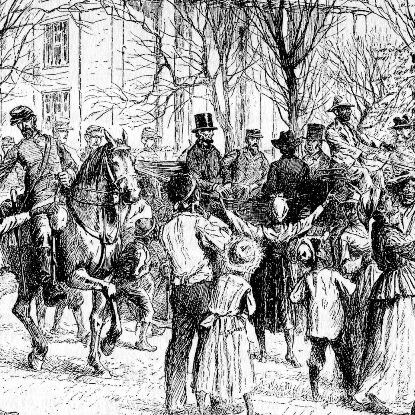
Battles and Leaders of the Civil War, Volume IV On April 4, 1865, two days after Confederate forces evacuated Richmond, President Abraham Lincoln and his son Tad visited the still smoldering ruins of the South's former Capital. As they stepped ashore, they were instantly recognized by the former slaves, who greeted them ecstatically. "No electric wire could have carried the news of the President's arrival sooner than it was circulated through Richmond. As far as the eye could see the streets were alive with negroes and poor whites rushing in our direction, and the crowd increased so fast that I had to surround the President with the sailors with fixed bayonets to keep them off….They all wanted to shake hands with Mr. Lincoln or his coat tail or even to kneel down and kiss his boots!" said Admiral David D. Porter, who landed with Lincoln. The crowd around Lincoln grew as he attempted to make his way to the former Confederate White House, now the U. S. military headquarters. Incredibly, only a few sailors were on hand to guard the President against attack. The distance to the White House was not great, but the crowd made movement nearly impossible. Military authorities eventually spotted the President and guided him to the house once occupied by Jefferson Davis, President of the Confederacy. It was here he hoped to meet with the commanding general of the occupying forces. Instead, he found a delegation of Southerners waiting to see him to discuss how the war might be brought to a speedy, peaceful conclusion. After the meeting a carriage was brought out, and Lincoln and Tad rode through Richmond, touring the sites made famous during the previous four years of war, including the State Capitol and Libby Prison. Finally, the President reached Rocketts Landing, where the USS Malvern had arrived, and boarded the warship for the night. The next morning, he resumed his peace talks and then departed Richmond, never to return. General Robert E. Lee's surrender four days later at Appomattox Court House ended attempts at a negotiated end to the war. Reflecting on the heady events of the past few days, Admiral Porter said, "I should have preferred to see the President of the United States entering the subjugated stronghold of the rebels with an escort more befitting his high station, yet that would have looked as if he came as a conqueror to exult over a brave but fallen enemy. He came instead as a peacemaker, his hand extended to all who desired to take it." Lincoln's assassination, less than a week following Lee's surrender, ensured that the events of the previous week would forever remain mysterious. Hundreds of fanciful, romantic, and second-hand accounts gained traction in the public mind, causing even Lincoln's first historians to throw up their hands in frustration at the lack of similarity in the accounts of his Richmond visit. Over time, the event faded from public memory. Interest returned on April 5, 2003, when the National Park Service unveiled a statue at the Historic Tredegar Iron Works commemorating Lincoln's 1865 visit to Richmond. The life-sized sculpture by David Frech features the President and his son Tad, resting on a bench in front of the words "To Bind up the Nation's Wounds" - a phrase taken from Lincoln's second inaugural address. 
NPS photo |
Last updated: December 21, 2022
